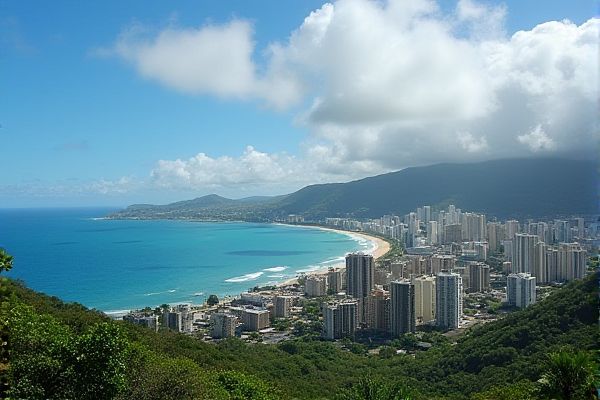
Housing market and best cities to live in Hawaii: Median home prices. Popular cities: Honolulu, Hilo, Kailua. Housing market trends. Proximity to beaches. School district quality. Crime rates. Cost of living comparison. Availability of rental properties. Local job market. Climate considerations.
Median home prices
The Hawaii housing market presents a fascinating landscape, with the median list price reaching approximately $799,000. This figure varies across the state's diverse cities, showcasing differing economic and real estate dynamics, such as $625,000 in Honolulu, $729,000 in Kailua-Kona, and $1,249,000 in Lahaina. As of August 2024, according to the Hawaii Housing Market, the median home price is around $784,500. This reflects significant growth and unique market conditions, highlighting the diverse appeal and competitive nature of Hawaii's real estate sector. The ongoing changes emphasize the importance of understanding local variations when engaging in property investments or sales within the state.
Popular cities: Honolulu, Hilo, Kailua
In Hawaii, popular cities like Honolulu, Hilo, and Kailua exhibit varied housing market trends. Honolulu is expected to see a price drop by August 2025, while Hilo is forecasted to experience a modest increase. Kailua, though not specifically mentioned in the forecast, is part of the broader Oahu market. Each city offers unique livability factors, with Honolulu known for its high livability and diverse real estate market, while Hilo is recognized as Hawaii's most liveable city with a strong tourist and agricultural sector. Kailua Kona serves as a hub for tourism and commercial industries on the Big Island. For more detailed insights, the Hawaii Housing Market report provides comprehensive information about these dynamic changes.
Housing market trends
The Hawaii housing market is characterized by a significant 12.3% increase in home prices from the previous year, reaching a median home price of $784,500. This market presents a diverse landscape, with regions like Urban Honolulu experiencing a seller's market, contrasted against areas such as Hilo and Kahului, which offer more balanced conditions. For more detailed insights into these varying trends and regional price fluctuations, you can refer to the Hawaii Housing Market report. Forecasts suggest that these fluctuations will continue through August 2025, providing both opportunities and challenges for potential buyers and sellers in different regions.
Proximity to beaches
For those seeking proximity to beaches, top cities in Hawaii include Honolulu, known for its iconic Waikiki Beach and Ala Moana Beach Park; Kailua, with its turquoise waters and soft sands at Kailua Beach Park; Kihei on Maui, renowned for its sunny weather and beaches like Kamaole Beach Park and Keawakapu Beach; and Hilo, featuring Richardson Beach Park and Onekahakaha Beach Park with their unique black sand and calm waters. For more detailed information, you can explore the Best Places to Live in Hawaii blog.
School district quality
In Hawaii, the quality of school districts varies, but top-rated elementary schools are often found in areas like Honolulu, where schools such as Nuuanu Elementary School and Mililani Ike Elementary School are highly ranked based on test scores and other performance metrics. These areas are considered desirable for families due to their strong educational offerings. For a detailed comparison of these schools, one can refer to the comprehensive rankings available on the SchoolDigger website.
Crime rates
Hawaii's crime rates vary, with the state having a higher property crime rate than the national average, but lower violent crime rates. Urban areas like Honolulu and Kahului have above-average rates of larceny and motor vehicle theft, while other regions show mixed crime trends, highlighting the need for careful consideration when choosing a safe city to live in. For more detailed insights and rankings of the safest cities in Hawaii, you can visit the analysis on SafeHome.org.
Cost of living comparison
The cost of living in Hawaii is significantly higher than the national average, with the total cost of living, including rent, being $2875 per month for one person and $7053 for a family of four. Housing costs are particularly high, with the median home price exceeding $800,000 and rental prices often unaffordable for a third of households, making cities like Honolulu, Maui, and Kailua challenging but desirable due to their robust job markets and cultural attractions. For more detailed information, you can visit the Cost of Living in Hawaii website.
Availability of rental properties
The availability of rental properties in Hawaii is limited, with only 2,281 rentals currently available, and the median rent has increased significantly over the last year to $2,938, highlighting a tight and expensive rental market. These trends underscore the challenges faced by renters in the state, necessitating strategic decision-making for both prospective tenants and landlords. For more detailed insights into these dynamics, you can explore the comprehensive analysis offered by Zillow Rental Manager.
Local job market
The local job market in Hawaii's best cities varies, with Honolulu seeing an increase in non-agricultural sector jobs, adding around 8,400 jobs in the third quarter of 2023. Other areas like Maui and Hilo have higher unemployment rates, with 8.4% in Hilo. However, Hawaii's robust job market and diverse economic sectors contribute to its attractiveness as a place to live. For more insights on the best places to reside, explore the Best Places to Live in Hawaii for a comprehensive guide on Hawaii’s vibrant locales.
Climate considerations
In Hawaii, climate considerations significantly impact the housing market, with high property values driven by the desirable tropical climate, but also posing risks such as coastal erosion, rising sea levels, and maintenance challenges due to humidity and extreme weather. Properties located inland or at higher elevations tend to maintain their value better, while areas like Urban Honolulu, Hilo, and Kahului offer varying market dynamics influenced by climate and local factors. For more insights, you can visit the Impact of Climate on the local real estate market.
